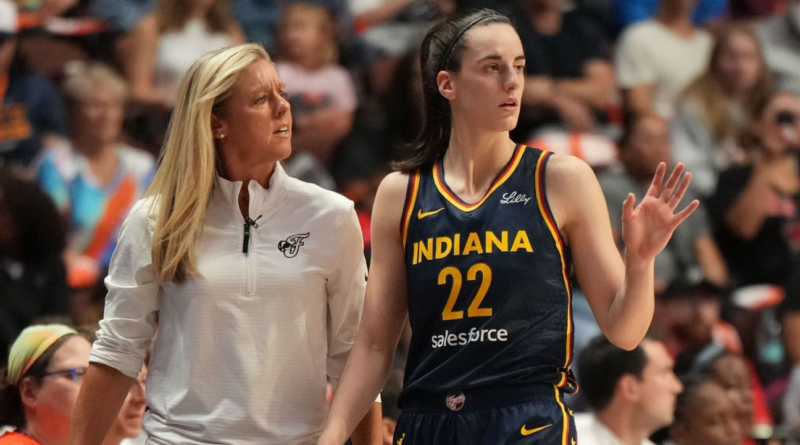Coach Christie Sides is out in Indiana; what's next for the Fever?
The Indiana Fever fired Christie Sides on Sunday, leaving six of the WNBA’s 12 teams from the 2024 season without a head coach. It has been that kind of fast-moving, news-making stretch for the WNBA, which has been in a brighter spotlight this year than ever before.
Sides went 20-20 this season as the Fever returned to the playoffs for the first time since 2016 behind the play of Caitlin Clark and Aliyah Boston, the past two Rookie of the Year winners. Now with Kelly Krauskopf returning as Fever president and Amber Cox joining as general manager, the organization is also getting a new head coach, parting with Sides after two seasons.
Sides’ departure is the latest coaching domino to fall since the Los Angeles Sparks fired Curt Miller on Sept. 24. Two days later, Teresa Weatherspoon was let go after one season with the Chicago Sky. On Oct. 2, the Atlanta Dream fired Tanisha Wright, and the Dallas Wings fired Latricia Trammell on Oct. 18. Then on Oct. 23, coach Eric Thibault and general manager Mike Thibault were let go by the Washington Mystics.
All four teams that missed the playoffs and are in the Nov. 17 draft lottery are looking for new head coaches. And when the 2025 season tips off, there will be at least six new head coaches to open a season for the first time since the WNBA launched, according to the Elias Sports Bureau.
That doesn’t include the expansion Golden State Valkyries, who named Natalie Nakase their first head coach on Oct. 10.
Will any of the openings be filled by a current WNBA head coach, or by one of the recently fired coaches? What does all this movement mean for the league? ESPN’s Alexa Philippou, Kevin Pelton and Michael Voepel look at the WNBA’s coaching carousel.
Was this coaching move a surprise? Was Sides’ season considered a success?
Philippou: The start to the season was shaky as the Fever opened 2-9, but they ultimately did what they sought to do: make the playoffs for the first time since 2016. It took time for the Fever to find an identity, but Sides managed to right the ship for a strong second half in which they produced the league’s best offense after the Olympic break. Lin Dunn — who moved from general manager to senior adviser for the franchise — said in September that the team was right where it needed to be in her three-year rebuild plan.
It feels like this firing had more to do with looking ahead and wanting to maximize the talent of Clark, Boston and (if they can re-sign her) Kelsey Mitchell — perhaps with an even more experienced and proven coach — than a referendum on last year.
It’s perhaps not entirely surprising if you look at what the Fever have done in the offseason: They brought back Krauskopf, who led the franchise from 2000 to 2018 before leaving for an assistant general manager role with the Indiana Pacers, and hired Cox (recently COO of the Wings) to serve as general manager. That wave of new leadership trickled down to who was running the show on the sideline.
1:55
How Caitlin Clark paved her way as WNBA’s Rookie of the Year
Chiney Ogwumike looks back at Caitlin Clark’s record-breaking season that led her to becoming the WNBA Rookie of the Year.
What’s the No. 1 priority for a new coach in Indiana?
Voepel: The Fever this season were in a media and social media whirlwind like we’ve never seen in the WNBA. Fans criticized almost every move Sides made.
But Sides and the Fever realized they needed to tune out as much of the social media noise as possible and focus on the talent and chemistry they had. With that mindset, the Fever played better once they got past the gauntlet at the beginning of their schedule: 11 games in their first 20 days, including three vs. New York and two vs. Connecticut in that stretch.
Considering where the Fever were when Sides was hired before the 2023 season and where they are now, she did her job. Getting stars like Clark and Boston was key to that, but Sides took a lot of slings and arrows for the organization and handled it with grace.
The expectations are huge going forward for Sides’ successor. The Fever were most successful when playing at the fast pace in which Clark is most comfortable. She and Boston developed good chemistry in the pick-and-roll, and the team improved defensively, which contributed to victories, too. Clark will look to cut down on turnovers, but her rookie year was fantastic and a great building block. Sides’ replacement has a lot to work with, especially if Mitchell returns.
Why is this hire so important for the Fever?
Pelton: If you look at the history of generational talents like Clark, the majority of them have maximized their potential under their second WNBA head coach. Of the six No. 1 picks in league history who have gone on to win MVP — Lauren Jackson, Maya Moore, Nneka Ogwumike, Candace Parker, Breanna Stewart and Diana Taurasi — four of them went on to win championships for the first time with the team’s second full-time head coach during their careers.
The exceptions to that group were Moore, whose Minnesota Lynx won the first of their four titles under Cheryl Reeve during her rookie season, and Parker, who was on her fourth WNBA head coach (Brian Agler) by the time the Sparks won the 2016 title.
Perhaps the best comparison for the Fever changing coaches now involves Jackson and fellow No. 1 pick Sue Bird, drafted first overall by the Seattle Storm in back-to-back years like Boston and Clark. Although the Storm had a strong coach in Dunn, who went on to win a WNBA title in Indiana, they made a coaching change after making the playoffs in Bird’s rookie season and Jackson’s second.
Taking advantage of the attractive opportunity to coach two budding stars, Seattle hired Anne Donovan away from the Charlotte Sting after she’d reached the WNBA Finals in Charlotte. Two years later, with Bird and Jackson age 23, the Storm won a championship. Given the potential of Clark and Boston, those are the kinds of stakes at play for the Fever with this hire.
The worst-case scenario for Indiana is what happened with Parker’s prime years. After Michael Cooper left the Sparks to take the head-coaching job at USC, Los Angeles cycled through multiple coaches before Agler brought stability to the organization and Parker won her first championship at age 30.
Why has there been so much upheaval this offseason in the WNBA?
Pelton: Talking with people in the league, increased resources and greater attention on the WNBA both seem to be factors. As teams invest more in practice facilities and travel and reap greater financial rewards in terms of ticket sales and sponsorships for being successful, there’s more money to spend on coaches and greater urgency to get a return on that investment by winning big.
Philippou: With that in mind, though, will rapidly cycling through coaches guarantee more success? It’s worth noting that four of these fired coaches had been at the helm for two years and one (Weatherspoon) for just one season. Wright, the longest tenured of the group, had been in Atlanta for only three years. Many of these franchises have also been prone to coaching turnover in general: The Fever, for example, haven’t had a coach last longer than three seasons since Dunn (2008-2014), while the Wings are looking for their fifth head coach since the organization moved to Dallas in 2016.
There’s a fine line between prioritizing winning in this incredible moment for women’s basketball but also not going through coaches so quickly that it erodes a franchise’s opportunity to establish stability or build something special with time.


 This year in odd news: The weirdest headlines from the Houston area in 2022 – KPRC Click2Houston
This year in odd news: The weirdest headlines from the Houston area in 2022 – KPRC Click2Houston 

